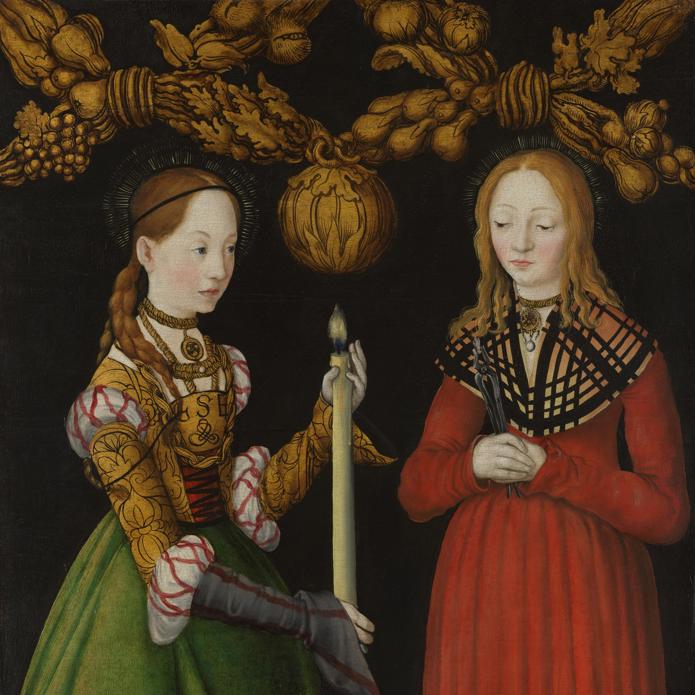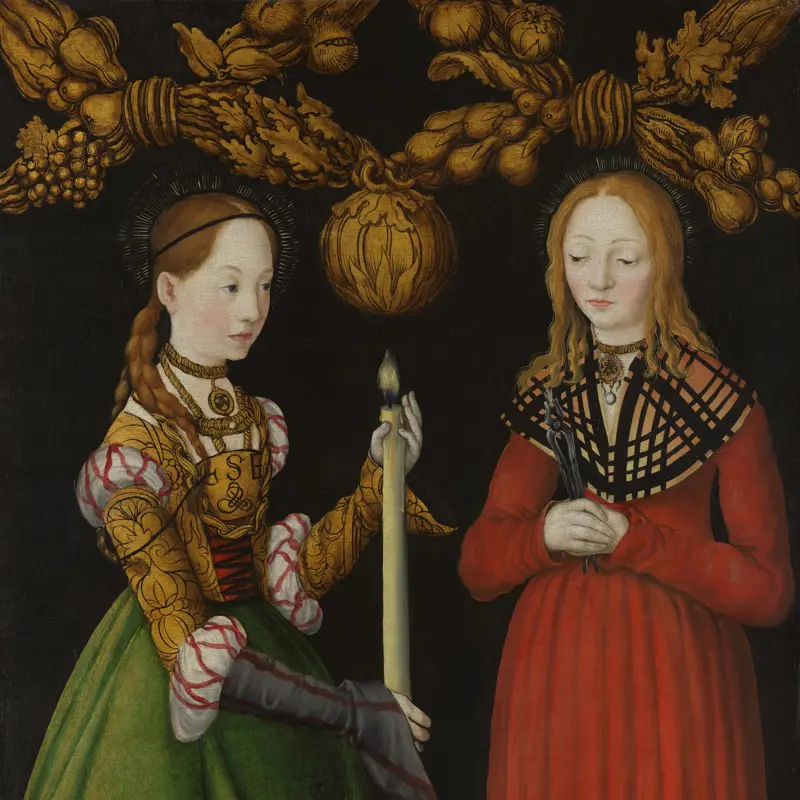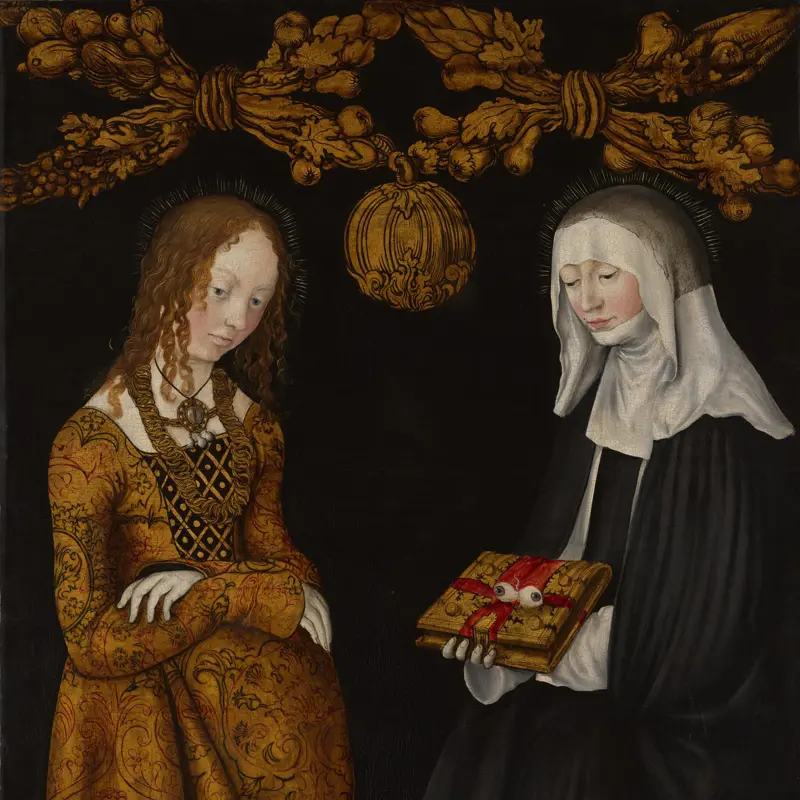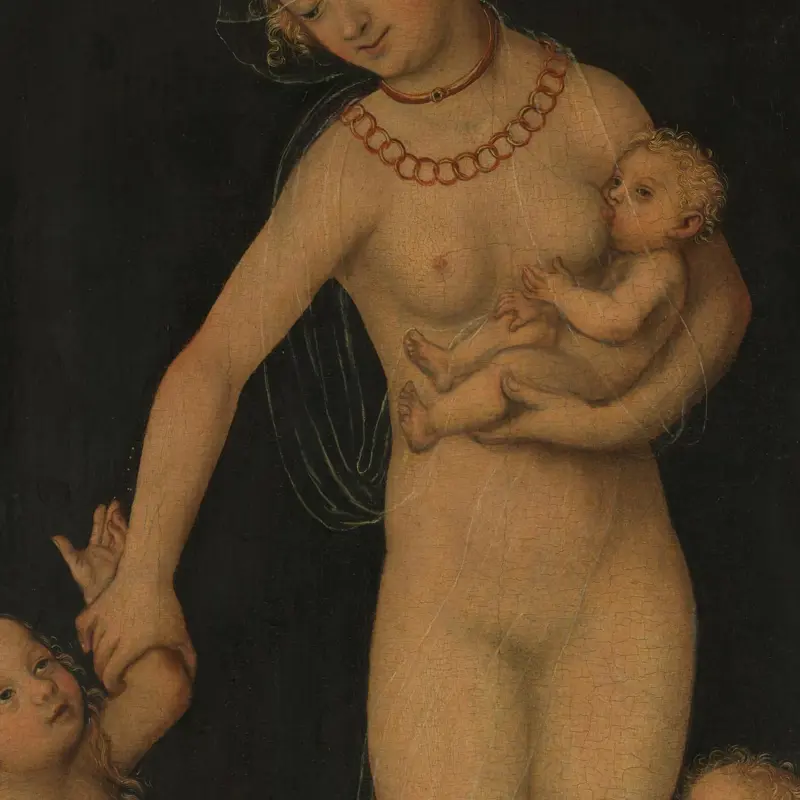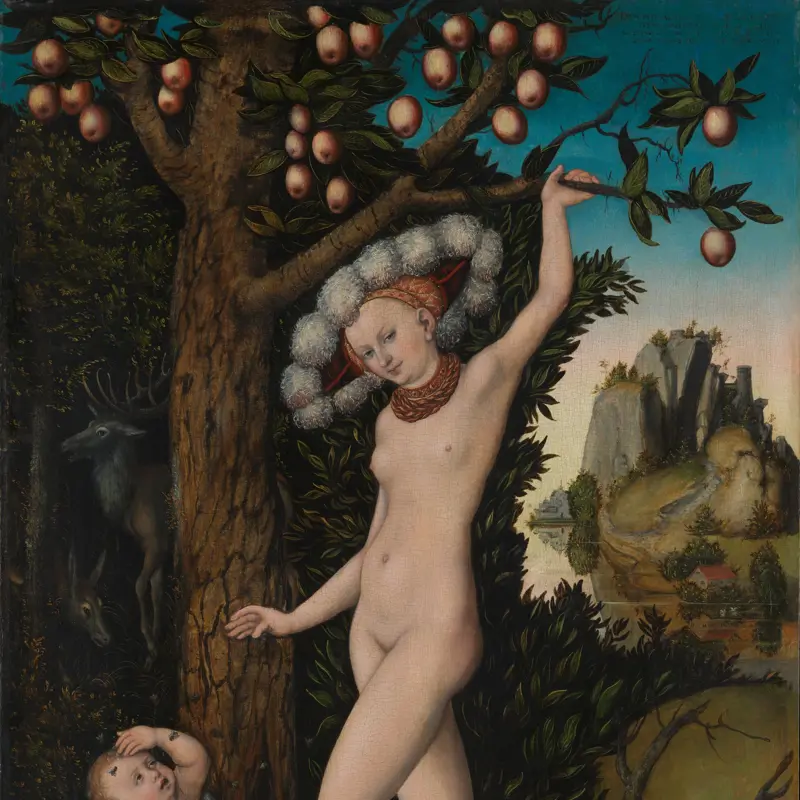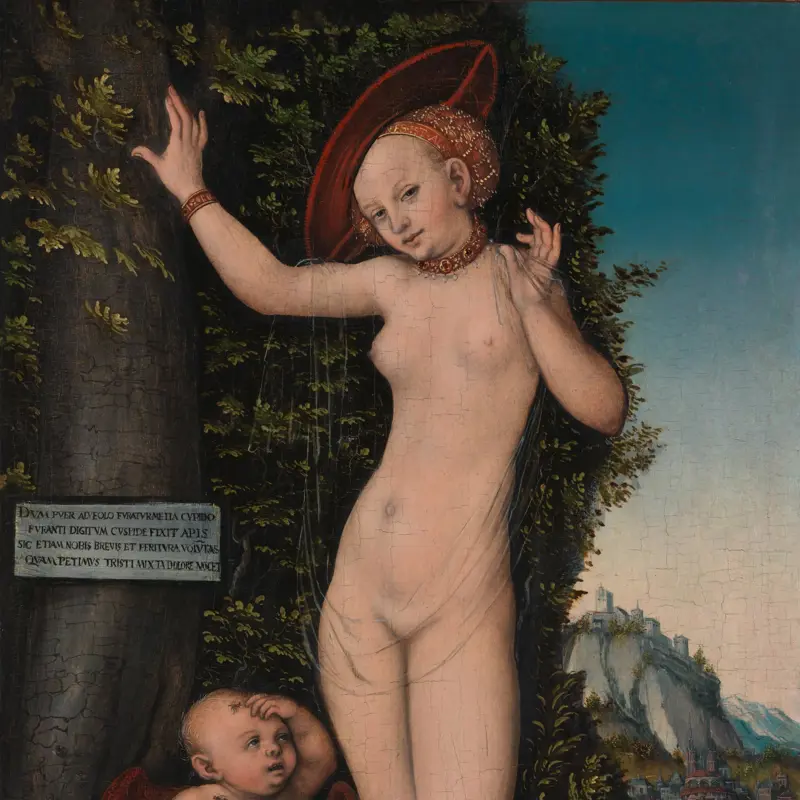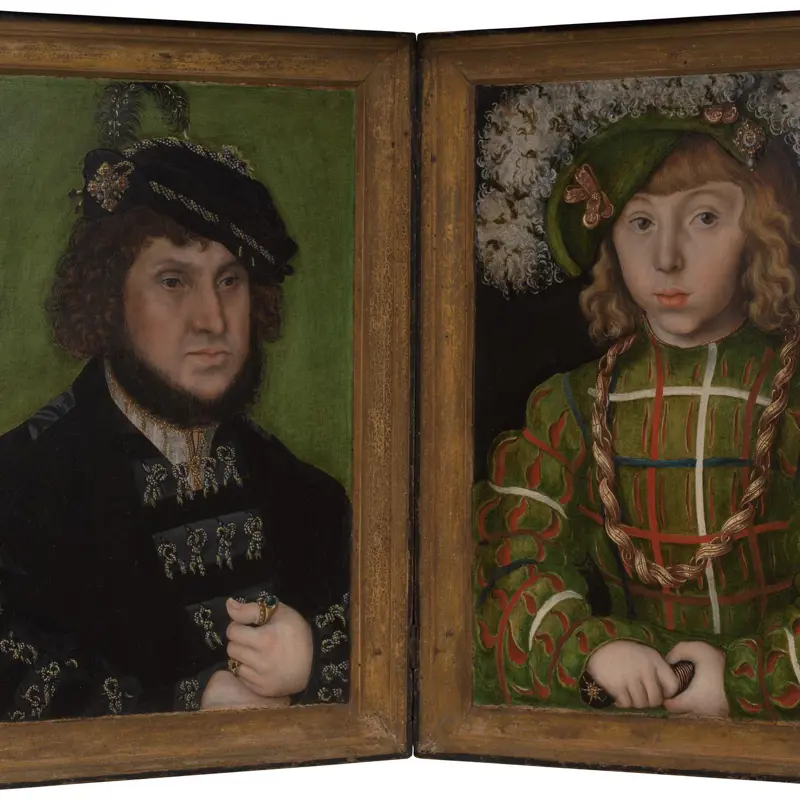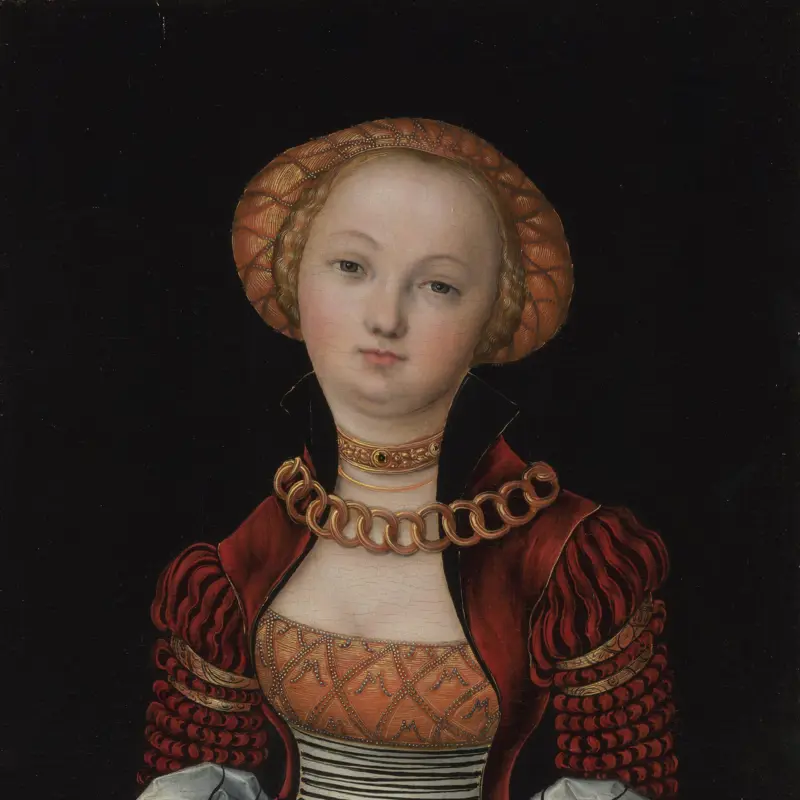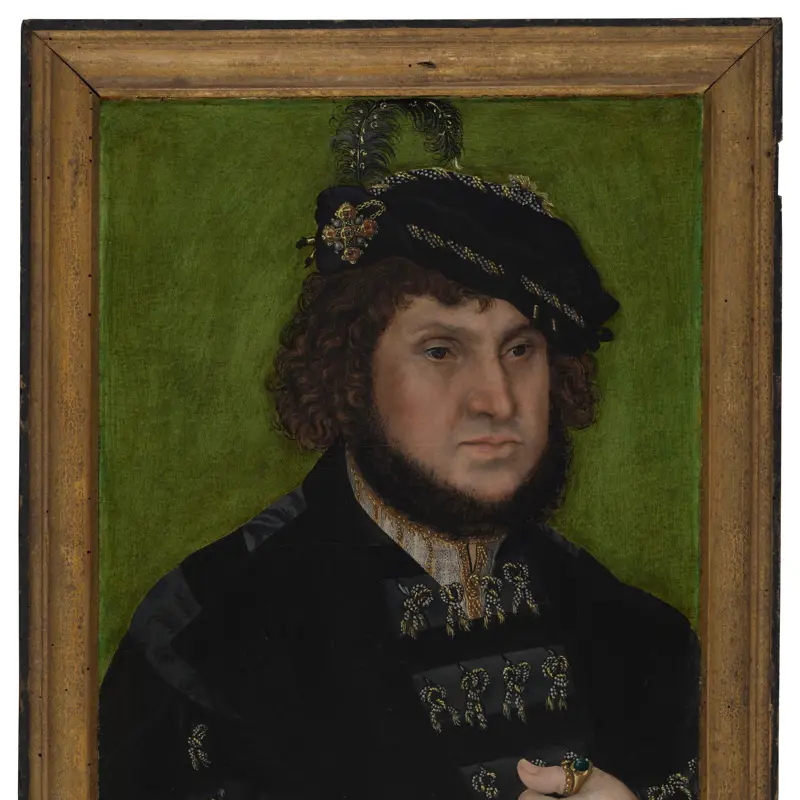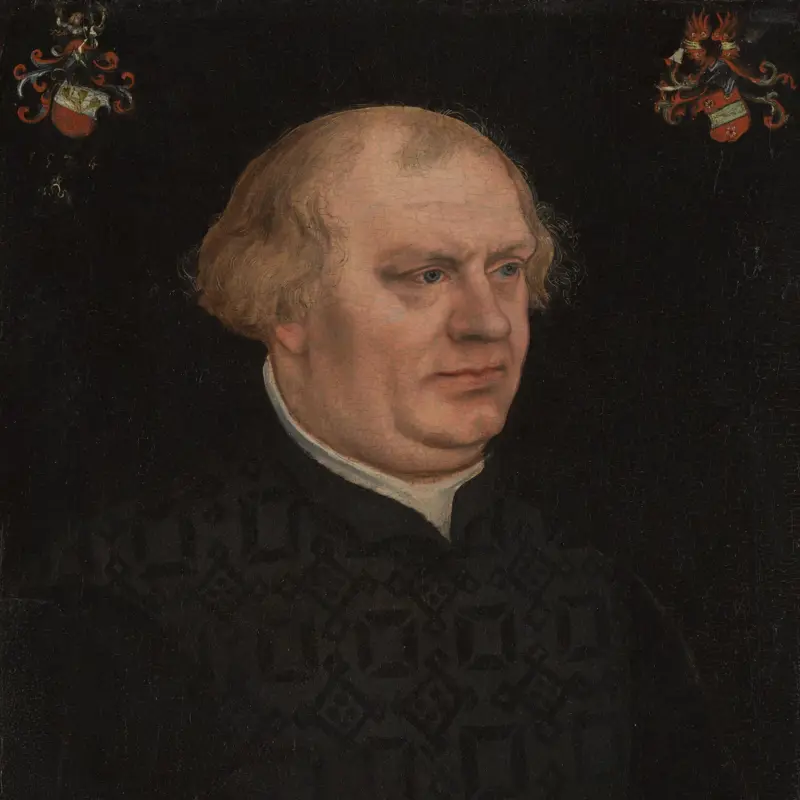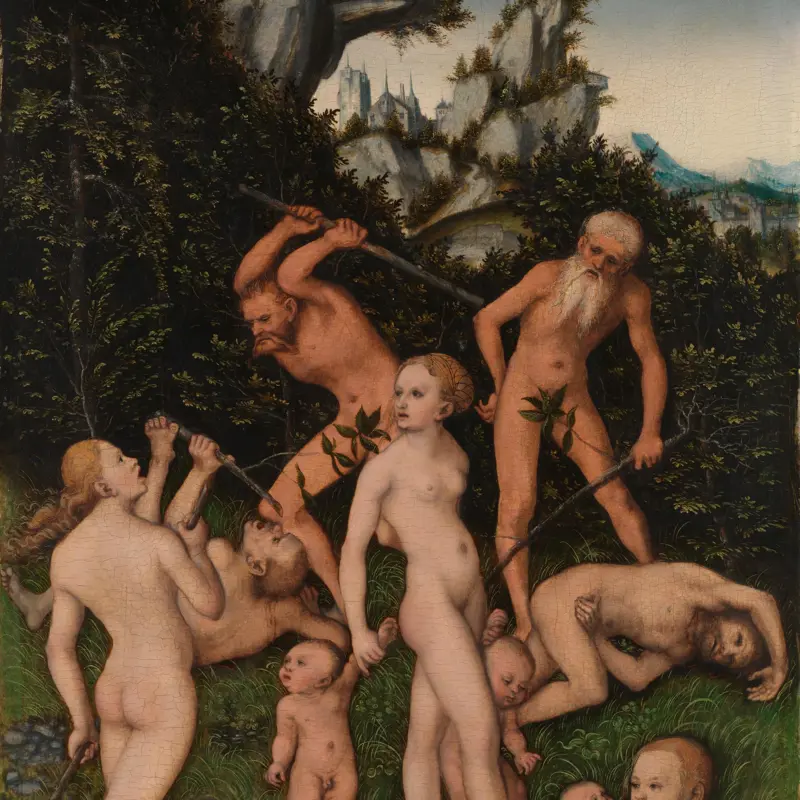Lucas Cranach the Elder, 'Saints Christina and Ottilia', 1506
About the work
Overview
This painting, which shows Saints Christina and Ottilia, was part of a multi-panelled altarpiece made by Cranach in 1506, shortly after he was appointed court painter to the Elector of Saxony, Friedrich the Wise.
Saint Christina of Bolsena was a third-century virgin martyr. When she renounced her pagan faith and converted to Christianity, her father ordered her torture – but every attempt was thwarted and Christina remained miraculously unharmed. She stands on the stone to which she was tied before being thrown in a lake. Despite the heavy weight, she floated. She was eventually killed by beheading.
Saint Ottilia of Alsace was a Benedictine nun whose blindness was miraculously cured during her baptism into the Christian faith. She went on to bring her brother back to life after their father accidentally killed him, and was the founder of numerous monasteries.
Key facts
Details
- Full title
- Saints Christina and Ottilia
- Artist
- Lucas Cranach the Elder
- Artist dates
- 1472 - 1553
- Part of the series
- The St Catherine Altarpiece: Reverses of Shutters
- Date made
- 1506
- Medium and support
- Oil on wood (probably lime)
- Dimensions
- 123 × 67 cm
- Acquisition credit
- Bought, 1987
- Inventory number
- NG6511.2
- Location
- Room 55
- Collection
- Main Collection
- Frame
- 21st-century Replica Frame
Provenance
Both paintings are first recorded in the copies of the Saint Catherine Altarpiece made by the Torgau painter Daniel Fritsch, which are dated 1586 and 1596 (now Gotisches Haus, Stiftung Dessau Wörlitz and the Evangelical church (Dorfkirche), Berlin, Alt-Tempelhof, respectively). According to an inventory taken at Schloss Hartenfels, Torgau, in 1610 there was in the ‘Schöne Fürstenkammer’ an ‘alte gemahlte Taffel von Ölfarben darauff die Historien von der Catharina’ (‘an old picture painted with oil paints on which is the story of Catherine’), described in 1601 merely as a ‘grosser Flügelaltar mit vergoldetem Rahmen’ (‘a large winged altar with a gilded frame’), which can probably be identified with Cranach’s altarpiece.
The altarpiece was brought to Dresden from Torgau in 1738 by the court painter Bonaventura Rossi. It can evidently be identified in the ‘Specification derjenigen Bilder, so von Monsieur Rossi von dem Schlosse zu Torgau mit nach Dresden genommen worde’ that was drawn up in Torgau on 12 July 1738, as number 2, ‘Ein Bild, worauff die Historia der Dorothea auf Holz, in 3 Feldern gemahlt’. The whole altarpiece is first recorded in the Dresden royal collection from 1786 in records of paintings to be sold; the wing panels had evidently been sawn in two by this date, separating the front and back, as inner and outer panels were listed separately.The two outer sides of the wings were sold in 1797 together with one interior side of a wing: the panel with Saint Apollonia (NG 6511.1) was sold on 27/28 July for 2 Thaler 8 Groschen and the Saint Ottilia panel (NG 6511.2) on 2 December for 11 Groschen.
All three panels were acquired at an unknown date, probably via the Dresden painter Ferdinand Hartmann (1774–1842), by Heinrich Wilhelm Campe (1771–1862), a Leipzig businessman and collector, and sold on 24 September 1827 in Leipzig. The National Gallery panels are listed in the sale catalogue as numbers 286 and 287, by Hans Holbein the Elder; number 300, the interior panel depicting Saint Dorothy and her companion, was sold as by Hans Baldung Grien. The latter was acquired by the Leipzig collector Maximilian Speck von Sternburg (1776–1856), and remained in the possession of his descendents until acquired by the Dresden Gemäldegalerie in 1996, where it had been on loan since 1931. NG 6511.1 and NG 6511.2 were purchased at the 1827 sale by a Berlin dealer, ‘v.d. Laar’, perhaps the artist Ferdinand von Laer (active 1828–1840), for a total of 50 Thaler 4 Groschen. By 1875 they were in the collection of the banker and Trustee of the National Gallery, Samuel Jones-Loyd, 1st Baron Overstone (1796–1883). They were inherited by his descendants and acquired by the National Gallery from the Loyd Trustees through a private treaty sale in 1987.
Additional information
Text extracted from the ‘Provenance’ section of the catalogue entry in Susan Foister, ‘National Gallery Catalogues: The German Paintings before 1800’, London 2024; for further information, see the full catalogue entry.
Exhibition history
-
2014Strange Beauty: Masters of the German RenaissanceThe National Gallery (London)19 February 2014 - 11 May 2014
Bibliography
-
1934Ashmolean Museum, Pictures from Lockinge House, Wantage, Oxford 1934
-
1956Thos. Agnew & Sons, Summer Exhibition of Pictures by Old Masters: Including a Group on Loan from the Lockinge Collection (exh. cat., Thos. Agnew & Sons, 6 June 1956 - 21 July 1956), London 1956
-
1988National Gallery, The National Gallery Report: January 1985 - December 1987, London 1988
-
2001
C. Baker and T. Henry, The National Gallery: Complete Illustrated Catalogue, London 2001
-
2024S. Foister, National Gallery Catalogues: The German Paintings before 1800, 2 vols, London 2024
About this record
If you know more about this work or have spotted an error, please contact us. Please note that exhibition histories are listed from 2009 onwards. Bibliographies may not be complete; more comprehensive information is available in the National Gallery Library.
Images
About the series: The St Catherine Altarpiece: Reverses of Shutters
Overview
These paintings were originally part of a multi-panelled altarpiece with wings that could be closed to cover the central panel. As the backs of the wings could sometimes be seen, they were also decorated; that’s where these four figures, of Saints Genevieve and Apollonia, and Saints Christina and Ottilia, once appeared. These images have since been separated from the inner faces of the wings.
This altarpiece was one of the first commissions Cranach made for the electors of Saxony and was almost certainly displayed in the electors’ chapel in the castle at Wittenberg. The central panel, now in the Staatliche Kunstsammlungen in Dresden, depicts the martyrdom of Saint Catherine witnessed by Elector Friedrich the Wise and possibly Johann the Steadfast.

